Guilin SightseeingΕπισκεφθείτε τα ορόσημα του Γκουιλίν και βυθιστείτε στον κινεζικό πολιτισμόΤο τοπίο του Guilin έχει ονομαστεί το καλύτερο κάτω από τον ουρανό. Βρίσκεται στα βορειοανατολικά της αυτόνομης περιοχής Guangxi Zhuang, το Guilin είναι το λαμπερό μαργαριτάρι της Νότιας Κίνας, με καταπράσινα βουνά, κομψά νερά, υπέροχους βράχους και φανταστικά σπήλαια. Ως κέντρο τουρισμού, το Guilin μπορεί να υπερηφανεύεται για την υπέροχη φυσική ομορφιά και πολλά πολύτιμα πολιτιστικά κειμήλια. Το Guilin είναι σχετικά απαλλαγμένο από ατμοσφαιρική ρύπανση. Αυτό που το κάνει ξεχωριστό είναι η γειτνίασή του με πολλά γραφικά ασβεστολιθικά βουνά και σχηματισμούς. Αξίζει επίσης να κάνετε κράτηση για μια περιήγηση στους ορυζώνες με ταράτσα περίπου μία ώρα έξω από την πόλη. Μια βόλτα με βάρκα γύρω από τα κύρια αξιοθέατα είναι πλέον διαθέσιμη τη νύχτα. Τα πάντα φωτίζονται από φώτα νέον και το σκάφος διασχίζει τις πλωτές οδούς ενώνοντας τα κύρια αξιοθέατα.
Το πάρκο είναι προικισμένο με κομψά βουνά, καθαρά νερά, θαυματουργό πέτρινο δάσος, βαθιές και γαλήνιες κοιλάδες, άφθονα ζώα και φυτά και πολύτιμα πολιτιστικά κειμήλια. Είναι δημοφιλές από τις δυναστείες Sui (581-618) και Tang (618-907). Τα κυριότερα αξιοθέατα περιλαμβάνουν τη Γέφυρα των Λουλουδιών, το Όρος Putuo, το Σπήλαιο Επτά Αστέρων, τον Λόφο της Καμήλας, τον Λόφο Ημισελήνου, το δάσος Guihai Stele και την πλατεία Φως της Κίνας, όπου μπορείτε να βρείτε περισσότερες πληροφορίες ως εξής: Flower Bridge Χτισμένη στη δυναστεία Song (960-1279), η Flower Bridge είναι η παλαιότερη γέφυρα στο Guilin. Κάθε άνοιξη και καλοκαίρι ξεκινάει με τα ανθισμένα λουλούδια και τα ρυάκια, εξ ου και η ονομασία Flower Bridge. Το σημείο κλίσης της γέφυρας βρίσκεται στην ανεστραμμένη αντανάκλαση της αψίδας στο νερό που μοιάζει πάντα με πανσέληνο. Δεν αλλάζει ποτέ παρόλο που αλλάζει η ποσότητα του νερού. Όρος Putuo Το βουνό Putuo είναι το κύριο σώμα του πάρκου. Είναι αφθονεί με σπηλιές και περίπτερα. Στους νοτιοδυτικούς πρόποδες του βουνού βρίσκεται το φυσικό air condition Cave Xuanfeng. Στα μισά του βουνού βρίσκεται το Putuo Jingshe (ένα διώροφο περίπτερο). Στη δυτική κοιλιά του βουνού βρίσκεται το περίφημο Σπήλαιο Επτά Αστέρων, το οποίο ονομάζεται επίσης Σπήλαιο Qixia ή Σπήλαιο Bixu. Με τους πολυσχιδείς σταλακτίτες, σταλαγμίτες και πέτρινες κολόνες που σχηματίζονται από τον διαλυμένο ασβεστόλιθο, το σπήλαιο ονομάστηκε «Οικία των Αθανάτων». Στρίβοντας δεξιά και συνεχίζετε ανεβαίνοντας στο βουνό, βρίσκονται ο Τάφος των Τριών Στρατηγών και οι Τάφοι των 800 Ηρώων. Στην κορυφή του βουνού, υπάρχουν το πέτρινο δάσος Putuo, το Xuanwu Pavilion και το Zhaixing Pavilion. Επιπλέον, υπάρχουν πολλές πολύτιμες ταμπλέτες στο βουνό. Camel Hill
Ένας ερημίτης της δυναστείας των Μινγκ ζούσε κάποτε εδώ και φύτρωσε μεγάλους αριθμούς δαμασκηνιών. Την άνοιξη, το ολόσωμο άνθος της δαμασκηνιάς, μαζί με τις ακτίνες της ανατολής ή του ηλιοβασιλέματος ντύνει το λόφο με μια υπέροχη λάμψη. Αυτή είναι μια από τις Δέκα Σκηνές του Γκουιλίν. Γύρω από το λόφο υπάρχουν κήποι μπονσάι, ζωολογικός κήπος και τεϊοποτεία. Το Camel Hill είναι ένα εντυπωσιακό θέαμα. Όντας τόσο σαν μια καμήλα, είναι δύσκολο να πιστέψει κανείς ότι είναι ένας εντελώς φυσικός σχηματισμός. Crescent Hill Walking into the park, there is Crescent Hill on the right. The hill was given its name due to the crescent-shaped stone at its belly. A notable feature of this hill is the 200 calligraphy carvings in the caves, located on the hill. These carvings are said to be the work of important and talented calligraphers of the Tang, Ming and Qing Dynasties. On top of the hill, pavilions, kiosks and towers line the path, each offering excellent views of the Xiao Dongjiang River. Standing from Crescent Hill, the sights of Guilin City can be seen. At the southwestern foot, there is Guihai Stele Forrest, which consists of Longyin Cave, Longyin Rock. The Guihai Stele Forrest has more than 100 tablets, referring to politics, economy, culture and military affairs in the form of poems, posies, couplets and images. The characters in the tablets are inscribed in regular script, cursive script, seal characters and clerical script. Seven StarsCave Seven Stars Cave a further two-minute walk upon leaving Putuo Jingshe leads to Seven Stars Cave. The Seven -StarCave is a must see. This is the most famous of the scenery in Guilin. Eroded by water over thousands of years, the cave is a wonderland of stalactites, stone pillars and rock formations resulting from carbonate deposition. All year, the temperature within the cave remains at a constant 20 degrees Celsius and has been a tourist attraction since the Tang Dynasty. However, for despite its splendor, the Seven Stars Cave is overshadowed by the awe-inspiring Reed Flute Cave to be found five kilometers northwest of the city. Guihai Stele Forest
Light of China Square The Light of China Square is between Putuo Mountain and Crescent Mountain. It boasts of two craftworks, one of which is the stone carving murals and the other is Shi Ji Bao Ding, the precious Ding of the century. Shi Ji Bao Ding, a four-legged Ding at a height of 4.6 meters (15 feet), symbolizes that the country flourishes and people live in peace.
Li River, Taohua River, Shahu Lake, Ronghu Lake, Guihu Lake and the newly dug Mulong Lake are all interconnected. The waterway transportation makes up of Guilin's central round-the-city water system, called "Two Rivers and Four Lakes". More than 1000 years ago Guilin formed a complete moat river system. Tour and Recreation on water had been very much in a fashion in the Tang and Song Dynasties, and remains so in present day.
Li River is a major component of Guilin scenery. As it sparkles in the sunlight the river meanders through lush mountains like a liquid jade belt. Guilin's scenery is unique both to China and to the rest of the world. Emerging from a flat green plane laced with rivers and lakes the Karst formations are steep, rounded towers of stone which stand in a line like battlements. This bizarre range of peaks has caused Guilin to be immortalized in Chinese painting and poetry. The Li River cruise from Guilin to Yangshuo is the centerpiece of any trip to northeastern Guangxi Province. The Li River of Guilin tour begins at Cat Mountains in Xing'an County and flows through Guilin, Yangshuo, and enters into West River in Wuzhou, totaling 437 kilometers. The river trip is over eighty kilometers (52 miles) long and takes about seven to eight hours to enjoy the eye-feasting grotesque peaks and the landscape appears to be a beautiful sketch. Water buffalo patrol the fields, peasants reap rice paddies, school kids and fisherman float by on bamboo rafts. With its breathtaking scenery and taste of a life far removed from the concrete metropolis, the scenery along the Li River become one of China's top tourist destinations. It is a Chinese tradition to divide the long trip into sections and give each peak an imaginative name. Although some take some imagination to see what it is like, listening to a tour guide's legendary stories behind them is a delightful experience. Most are mystical fairy and love stories.
The whole hill looks similar to a huge elephant stretching its trunk drinking water by the Li River. It is the masterpiece of Karst landscape, composed of pure limestone deposited on seabed 360 million years ago. Between the trunk and the legs of the "Elephant Trunk Hill" is a cave in the shape of a full moon, penetrating the hill from side to side. People named it "Moon Over Water Cave". When the waters wave and the moonlight gleam, the scene is exceedingly enchanting. On the walls in and around this cave, over 70 inscriptions from the Tang and Song Dynasties were found, praising the beauty of hills and waters nearby.
Perching on the northern bank of Li River, the ancient town of Daxu is kept in its antique style from the Ming Dynasty (1368-1644). A flagging street, lined with old residences, shops and stalls, runs two kilometers along the river bank through the town. Some well-preserved residences hidden behind the street door may surprises visitors when they occasionally explore further into a shop. These were quarters for businessmen in past times. When in Daxu Town, visitors should try some of the various dumping snacks sold in the stalls or peddle cars along the street. Visitors may be surprised with both its good taste and cheap price. People in the town are very kind to tourists. Further to south, there is a single-arched bridge in the town named the Longevity Bridge. The town is really a sight off-the-beaten track. Opposite the town on the other side of the river, a millstone-like rock with the running waters creates the scene of Grinding Grain.
A crown-like cliff earns the hill its name. What makes the hill a worthy stop for both river cruise tourists and those arriving from Guilin City by bus tour is its twelve kilometer long water-eroded cave. It is a wonderland of various stalactite, stone pillars and rock formations in the cave. Since it opening to tourists in 1995, illuminating lights, sound control tour guide system and escalators have been set-up in the scenic area and sightseeing cars and boats enable visitors to tour inside the cave. This site as an all-round tourist area includes cave visiting, country sightseeing and ethnic minority exploration. It is estimated to become an important excursion site along the Li River.
Not very far from the Crown Cave on the western bank, a huge rock descends into the river and cuts off a footpath by the water edge. Villagers have to take a ferry to reach the other side and continue the way. So, this spot gets its name Half-Side Ferry (for usually ferry means to transport people by boat across a body of water and reach the opposite bank). From Yangdi to Xingpin Down stream from Yangdi to Xingpin, the river passes an endless procession of distinct peaks and bamboo groves and the stunning landscape. This part is the highlight of the cruise. Pinnacled peaks pop up and surprise visitors at each bend of the river. Water buffalos patrol on the fields; ducks paddle in the waters; peasants reap paddies in front of village houses; fishermen use the cormorants to catch the fish and return them to the boat and kids go home singing songs. All these create an idyllic and beautiful scene of the life removed from concrete cities. Ένα φημισμένο αξιοθέατο είναι ο λόφος Mural, ένας βράχος ύψους 100 μέτρων, ο οποίος έχει ξεπεραστεί και έχει στρωματοποιημένη επιφάνεια βράχου σε διάφορες αποχρώσεις. Λέγεται ότι τα χρώματα παρουσιάζουν εννέα άλογα και ένα άτομο που μπορεί να τα αναγνωρίσει θεωρείται έξυπνο. Θρυλικές ιστορίες δίνονται σε βράχους και κορυφές λόφων και είναι μια ευχάριστη εμπειρία να εκτιμάς το εκπληκτικό τοπίο ακούγοντας την ερμηνεία του ξεναγού για τις ιστορίες πίσω από αυτό.
Το σπήλαιο Reed Flute πήρε το όνομά του από ένα είδος καλαμιού που φυτρώνει στη γειτονιά, το οποίο μπορεί να γίνει μελωδικό φλάουτο. Μέσα σε αυτό το διαβρωμένο από το νερό σπήλαιο βρίσκεται ένας εντυπωσιακός κόσμος με διάφορους μαγευτικούς σταλαγμίτες, πέτρινους στύλους, στήλη, πέτρινες κουρτίνες και πέτρινα λουλούδια. Φωτισμένο από χρωματιστό φωτισμό, το φανταστικό θέαμα βρίσκεται σε πολλές παραλλαγές κατά μήκος αυτής της σπηλιάς μήκους 240 μέτρων. Οι τουρίστες μπαίνουν στη σπηλιά και στη συνέχεια ακολουθούν μια διαδρομή σε σχήμα U για να δουν διάφορα σημεία, οπότε βγαίνουν από μια άλλη σπηλιά πολύ κοντά στην είσοδο.
Είναι ένα υπέροχο καρστ σπήλαιο με μυριάδες σταλακτίτες και σταλαγμίτες όλων των περίεργων σχημάτων: άλλοι σαν λιοντάρια, άλλοι σαν βατράχια και άλλοι σαν ένα κρυστάλλινο παλάτι. Αυτό που εντυπωσιάζει περισσότερο τους επισκέπτες στο Guilin είναι οι πέτρινες κουρτίνες, οι οποίες όχι μόνο διαθέτουν φανταστικές φόρμες αλλά και ηχηρούς ήχους. Όταν χτυπηθούν, μερικά δίνουν έναν ήχο που ακούγεται παρόμοιο με ένα τύμπανο. άλλοι παράγουν ένα δαχτυλίδι που ακούγεται σαν πιάνο. Οι μορφές και οι ήχοι εδώ κάνουν το σπήλαιο «το παλάτι τέχνης της φύσης». First officially opened to the public in 1962, the cave now is a main attraction in Guilin. It is a fantastic place where imagination will fly with strong wings. It is of course a must for all the visitors to Guilin.
With half of the hill stretching into the river, the 120 meters
long, 60 meters wide and 213 meters high hill, stands on its
own to the northeast of the city, on the west bank of the Li
River. The waves of the river are turned back when they meet
the stone blocks of the hill, hence the name "wave-curbing
hill". On the southern slope of the hill is Pearl Returning
Cave. At the foot of the hill is the famous Pearl Returning Cave, which is composed of many side-caves, linked like a labyrinth. A several-meter stalactite column, thick on top and tapering downwards, hangs all the way from the ceiling the ground. No visitors will see it without amazement. Since the space between the column and the ground seems to be the result of a sword cut it is named Sword Testing Stone.
Half way up the hill, a cave penetrates from north to south.
With two
Solitary
Beauty Peak (Duxiu Peak), towering
from the ground with an elevation of 216 meters, is known
as "Sky Supporting Pillar in the South". This is the
oldest place of interest in Guilin. Solitary Beauty
Peak stands in solitary grace at the center of the ancient
Mansion of Prince Jingjiang, a noble family in the Ming
Dynasty. During the Southern Dynasty (420-589), some
1500 years ago, Yan Yanzhi, governor of Guilin, wrote
the line: "none can surpass this solitary peak in
beauty"; hence the name Solitary Beauty Peak.
In ancient times about 2,000 years ago, the Ling Canal was an irrigation canal. The canal was once an important means of transports serving the region before railways and roads were constructed. Now this canal still serves it purposes by irrigating about 2700 hectare of agricultural lands. Looking at the way that the canal is constructed brings to
mind the wisdom achieved by the ancient peoples in the engineering
fields employed in the construction of dam and embankment.
Dams were mainly made of woods and stones. Studies revealed
that logs were first pile and stacks up in the water to stabilize
the ground. Thereafter, slabs of stone were placed against
the logs to form an embankment. Each stone slab has a groove
cut into it for an iron bar to slot through it to joint up
each slab together to form a continuous embankment, which stretches
for five hundred meters in length.
These tombs are well preserved, the site covers an area over 100 square kilometers with more than scattering 300 tombs. In front of each tomb stands Huabiao (ornamental column erected in front of palace, tombs), official stone statues, various animals such as tigers, lions and unicorns. These stone works were exquisitely made, primitively simple and stately.
XishanPark is the second largest park in Guilin, which is comprised of Xi Hill and Yin Hill. This used to be a shrine of Buddhism and one of the five Buddha Temples in the south.
Το Yu Hill Park είναι το λίκνο της ιστορίας του Guilin. Ο μύθος λέει ότι ένας από τους προγόνους της κινεζικής υπηκοότητας, ο Shun Yu επισκέφτηκε εδώ και οι άνθρωποι του Qin (BC220-BC206) έστησαν ναό για να τον απομνημονεύσουν. Τα τελευταία 2000 χρόνια, πολλοί άνθρωποι ήρθαν εδώ για να προσφέρουν θυσίες. ως εκ τούτου αυτό το πάρκο έχει μια ισχυρή επιρροή του Κομφουκιανισμού.
Το Yuzi Paradise είναι το μεγαλύτερο πάρκο γλυπτών στην Κίνα. Εκατόν δεκατέσσερις καλλιτέχνες από τουλάχιστον σαράντα επτά διαφορετικές χώρες έχουν συνεισφέρει σε αυτή τη θαυμάσια συμφωνία της φύσης και της ανθρωπότητας. Σε απόσταση 30 χιλιομέτρων (18,6 μίλια) από το Guilin, αυτό το πάρκο είναι ένας αρμονικός συνδυασμός ζωής και τέχνης. Δίνεται η ευκαιρία στους επισκέπτες να φτιάξουν πήλινα είδη υπό κατασκευή. Εκτός από τα παραπάνω πάρκα, το NanxiPark στα νότια της πόλης και το Chuanshan Park στα νότια προάστια έχουν το καθένα τη δική του ομορφιά και τα δικά του αξιοθέατα.
Το Bear and TigerPark είναι το μεγαλύτερο κέντρο άγριων ζώων. Εκεί διακρίνονται τέσσερις ράτσες τίγρεων που αντιμετωπίζουν εξαφάνιση. Πάνω από τριακόσιες τίγρεις, τετρακόσιες αρκούδες και εκατό λιοντάρια θα σας δώσουν μια νέα ιδέα για τις ανάγκες επιβίωσης τέτοιων άγριων ζώων. Επίσης, υπάρχουν παραστάσεις με ζώα, που σίγουρα θα ενθουσιάσουν μικρούς και μεγάλους.
Το Guilin Ocean World βρίσκεται στα νότια του NanxiPark. Εδώ διακρίνονται πολλά ενυδρεία που περιέχουν περίπου χιλιάδες ποικιλίες ψαριών. Το κέντρο διαθέτει μια περιοχή παρατήρησης, μια περιοχή επιδόσεων, μια περιοχή τροπικών δασών και καταρρακτών, μια συγκινητική περιοχή, υποθαλάσσια σήραγγα, θαλάσσια περιοχή και ούτω καθεξής. Θαλάσσιοι θησαυροί όπως γιγάντιες σαλαμάνδρα εκατοντάδων ετών, πνευμονόψαρο, ψάρια κλόουν, λουλούδια της θάλασσας, ναυτίλος, ζωντανά κοράλλια και καρχαρίες από όλο τον κόσμο μπορείτε να δείτε όλα εδώ.
Το Yangshuo, ένα πολύ γραφικό χωριό κατάντη του Guilin, αξίζει να επισκεφτείτε. Υπάρχουν επίσης βάρκες που πηγαίνουν στο Yangshou. Οι ταξιδιώτες μπορούν να κάνουν ένα ταξίδι στο ποτάμι στον ποταμό Λι με τουριστικά σκάφη. Από το Guilin στο Yangshuo, ο ποταμός περνά μέσα από μερικούς πραγματικά εντυπωσιακούς ασβεστολιθικούς σχηματισμούς και ένα αργό ταξίδι με πλοίο εκεί και πίσω, με μια στάση στο Yangshuo, θα διαρκέσει μια ολόκληρη μέρα. |

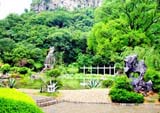 Το Seven-StarPark βρίσκεται στην όχθη του ποταμού Li που διασχίζεται από τον ποταμό Xiaodong, στο τέλος του Jiefang East Road, και περίπου ενάμιση χιλιόμετρο από την περιοχή του κέντρου της πόλης Guilin. Καλύπτοντας μια έκταση άνω των 120 εκταρίων (297 στρέμματα), αυτό είναι το μεγαλύτερο και πιο δημοφιλές πάρκο στο Guilin με τη μεγαλύτερη ιστορία.
Το Seven-StarPark βρίσκεται στην όχθη του ποταμού Li που διασχίζεται από τον ποταμό Xiaodong, στο τέλος του Jiefang East Road, και περίπου ενάμιση χιλιόμετρο από την περιοχή του κέντρου της πόλης Guilin. Καλύπτοντας μια έκταση άνω των 120 εκταρίων (297 στρέμματα), αυτό είναι το μεγαλύτερο και πιο δημοφιλές πάρκο στο Guilin με τη μεγαλύτερη ιστορία. 
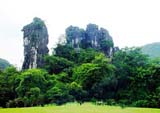 Το Camel Hill είναι ένα άλλο αξιοθέατο του πάρκου Seven Stars. Αυτή η ασβεστολιθική προεξοχή μοιάζει ακριβώς με καμήλα που ξεκουράζεται ανάμεσα στα δέντρα. Η κύρια είσοδος του πάρκου βρίσκεται πάνω από τη Γέφυρα των Λουλουδιών, μια κομψή τοξωτή κατασκευή που χρονολογείται από τη Δυναστεία Σονγκ που διασχίζει τη συμβολή του ρέματος Xiaodongjiang και Lingjian Stream που περνά μέσα από το πάρκο.
Το Camel Hill είναι ένα άλλο αξιοθέατο του πάρκου Seven Stars. Αυτή η ασβεστολιθική προεξοχή μοιάζει ακριβώς με καμήλα που ξεκουράζεται ανάμεσα στα δέντρα. Η κύρια είσοδος του πάρκου βρίσκεται πάνω από τη Γέφυρα των Λουλουδιών, μια κομψή τοξωτή κατασκευή που χρονολογείται από τη Δυναστεία Σονγκ που διασχίζει τη συμβολή του ρέματος Xiaodongjiang και Lingjian Stream που περνά μέσα από το πάρκο.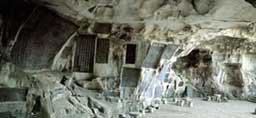 The
forest lies to the south of Yueya Hill. There are about 2,000
pieces of stone carvings and inscriptions in Guilin, of which
about 100 are in the Dragon Refuge Cave. In order to protect
historical relics, an exhibition hall has been built at the
entrance of the cave. Among the most famous and precious inscriptions
are "The Membership Roster of Yuan You Group", "Meizhi
on Five Miasmata", and "Eulogy to Five Gentlemen
by Huang Ting-jian". The exhibits have topics ranging
from politics to history, science and calligraphy.
The
forest lies to the south of Yueya Hill. There are about 2,000
pieces of stone carvings and inscriptions in Guilin, of which
about 100 are in the Dragon Refuge Cave. In order to protect
historical relics, an exhibition hall has been built at the
entrance of the cave. Among the most famous and precious inscriptions
are "The Membership Roster of Yuan You Group", "Meizhi
on Five Miasmata", and "Eulogy to Five Gentlemen
by Huang Ting-jian". The exhibits have topics ranging
from politics to history, science and calligraphy.
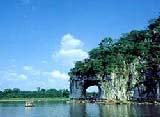 Xiangbishan,also called the Elephant Trunk
Hill, is situated majestically at the southeast of Guilin city
and west bank of Li River. It is the badge of Guilin city
and the landmark of Guilin landscape. Originally named "Li
Hill", "Yi Hill" and "Chenshui Hill",
the hill has a history of 3.6 hundred million years.
Xiangbishan,also called the Elephant Trunk
Hill, is situated majestically at the southeast of Guilin city
and west bank of Li River. It is the badge of Guilin city
and the landmark of Guilin landscape. Originally named "Li
Hill", "Yi Hill" and "Chenshui Hill",
the hill has a history of 3.6 hundred million years.  Halfway up the hill lays another cave, which goes through
the hill and serves as the eyes of the elephant, through which
visitors can overlook the beautiful scene of Guilin city.
On top of the hill stands a pagoda named Puxian Pagoda. Built
in the Ming dynasty (1368-1644), it looks like the handle of
a sword. In and out of the cave are many carvings and inscriptions,
the most well-known of which is a poem by Lu You, one of the
four great poets of the Southern Song Dynasty (1127-1279).
Halfway up the hill lays another cave, which goes through
the hill and serves as the eyes of the elephant, through which
visitors can overlook the beautiful scene of Guilin city.
On top of the hill stands a pagoda named Puxian Pagoda. Built
in the Ming dynasty (1368-1644), it looks like the handle of
a sword. In and out of the cave are many carvings and inscriptions,
the most well-known of which is a poem by Lu You, one of the
four great poets of the Southern Song Dynasty (1127-1279). Το σπήλαιο Reed Flute (Lu Di Yan) βρίσκεται στους πρόποδες του λόφου Guangming πέντε χιλιόμετρα (τρία μίλια) από το κέντρο της πόλης στο βορειοδυτικό προάστιο του Guilin. Το Reed Flute Cave είναι ένα λαμπρό σπήλαιο που σημειώνεται σχεδόν σε όλα τα ταξιδιωτικά δρομολόγια.
Το σπήλαιο Reed Flute (Lu Di Yan) βρίσκεται στους πρόποδες του λόφου Guangming πέντε χιλιόμετρα (τρία μίλια) από το κέντρο της πόλης στο βορειοδυτικό προάστιο του Guilin. Το Reed Flute Cave είναι ένα λαμπρό σπήλαιο που σημειώνεται σχεδόν σε όλα τα ταξιδιωτικά δρομολόγια. Είναι μια κινεζική συνήθεια να δίνουμε σε κάθε σχηματισμό ένα θρυλικό ή ποιητικό όνομα όπως Crystal Palace, Virgin Forest, Flower and Fruit Mountain και άλλα ενδιαφέροντα ονόματα. Αυτή η χώρα των θαυμάτων αναφέρεται ως Μουσείο Τέχνης της Φύσης. Περίπου 70 επιγραφές στον τοίχο του σπηλαίου λέγεται ότι είναι ταξιδιωτικά και ποιήματα που προέρχονται από τη δυναστεία των Τανγκ, η οποία έκανε το σπήλαιο δημοφιλές τουριστικό μέρος εκείνη την εποχή. Ένα πάρκο είναι χτισμένο για το σπήλαιο με ζιγκ-ζαγκ μονοπάτι, κομψά περίπτερα, λιμνούλες, γέφυρες, φυτά και άλλες κατασκευές κήπου.
Είναι μια κινεζική συνήθεια να δίνουμε σε κάθε σχηματισμό ένα θρυλικό ή ποιητικό όνομα όπως Crystal Palace, Virgin Forest, Flower and Fruit Mountain και άλλα ενδιαφέροντα ονόματα. Αυτή η χώρα των θαυμάτων αναφέρεται ως Μουσείο Τέχνης της Φύσης. Περίπου 70 επιγραφές στον τοίχο του σπηλαίου λέγεται ότι είναι ταξιδιωτικά και ποιήματα που προέρχονται από τη δυναστεία των Τανγκ, η οποία έκανε το σπήλαιο δημοφιλές τουριστικό μέρος εκείνη την εποχή. Ένα πάρκο είναι χτισμένο για το σπήλαιο με ζιγκ-ζαγκ μονοπάτι, κομψά περίπτερα, λιμνούλες, γέφυρες, φυτά και άλλες κατασκευές κήπου. The
east of the cave curbs the river stream, causing the formation
of a deep pool, so the hill is named Fubo Hill (Wave-Curbing
Hill). Fubo Hill is famous for its six beauties:
hills, water, caves, stones, courts, and cultural relics.
The
east of the cave curbs the river stream, causing the formation
of a deep pool, so the hill is named Fubo Hill (Wave-Curbing
Hill). Fubo Hill is famous for its six beauties:
hills, water, caves, stones, courts, and cultural relics.  Located north of Guilin city by the Li River, the Folded Brocade
Hill is one of the three most famous hills in Guilin (the other
two are Fubo Hill and Elephant Trunk Hill). It consists of
Yuyue Hill, Siwang Hill (Looking In Four Direction Hill), Crane
Peak and Bright Moon Peak. The hill is so named because layers
and layers of multi-colored rocks one atop another like a great
pile of folded brocade. Four small hills, Yuyue Hill, Siwang
Hill (All Direction Looking Hill), Crane Peak and Bright Moon
Peak surround Diecai Hill.
Located north of Guilin city by the Li River, the Folded Brocade
Hill is one of the three most famous hills in Guilin (the other
two are Fubo Hill and Elephant Trunk Hill). It consists of
Yuyue Hill, Siwang Hill (Looking In Four Direction Hill), Crane
Peak and Bright Moon Peak. The hill is so named because layers
and layers of multi-colored rocks one atop another like a great
pile of folded brocade. Four small hills, Yuyue Hill, Siwang
Hill (All Direction Looking Hill), Crane Peak and Bright Moon
Peak surround Diecai Hill. 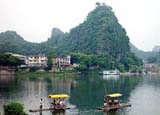 spacious mouths and a narrow middle, the cave takes
a shape of a calabash. The cave adopted its name for a cool
breeze continually blows in the cave all year round. It is
well-known for 90 Buddha images of the Tang and Song Dynasties.
After thousands of years' rain and wind, these images are still
vivid and life-like. On the top of the hill stands the cloud
catching Pavilion, which commands a panoramic view of the city
below.
spacious mouths and a narrow middle, the cave takes
a shape of a calabash. The cave adopted its name for a cool
breeze continually blows in the cave all year round. It is
well-known for 90 Buddha images of the Tang and Song Dynasties.
After thousands of years' rain and wind, these images are still
vivid and life-like. On the top of the hill stands the cloud
catching Pavilion, which commands a panoramic view of the city
below.  The
Tombs of Prince Jingjiang is a state cultural
relic. Located in an eastern suburb at the foot of Yao Mountain
in east suburb seven kilometers from Guilin, there is an important
imperial mausoleum historical site where eleven princes of
the Jingjiang Family during the Ming Dynasty (1368-1644) are
buried.
The
Tombs of Prince Jingjiang is a state cultural
relic. Located in an eastern suburb at the foot of Yao Mountain
in east suburb seven kilometers from Guilin, there is an important
imperial mausoleum historical site where eleven princes of
the Jingjiang Family during the Ming Dynasty (1368-1644) are
buried.  The Jingjiang Family is comprised of the descents of King
Jingjiang, the nephew of a Ming Emperor. During the earlier
Ming period, to strengthen the centralization of state power,
Ming Emperor Taizu (the first Ming emperor) designated his
24 sons as kings to administer different areas in China. King
Jingjiang got his title and built his palace at the foot of
Solitary Beauty Peak. The descendent kings chose this mausoleum
site as their burial place.
The Jingjiang Family is comprised of the descents of King
Jingjiang, the nephew of a Ming Emperor. During the earlier
Ming period, to strengthen the centralization of state power,
Ming Emperor Taizu (the first Ming emperor) designated his
24 sons as kings to administer different areas in China. King
Jingjiang got his title and built his palace at the foot of
Solitary Beauty Peak. The descendent kings chose this mausoleum
site as their burial place. Towering high up in the Shan Lake, the two towers, Golden Tower and Silver Tower,
are quite an eye-striking sights. The Golden Tower is a nine-storied architecture
of 41 meters high. Built with copper, it ranks as the highest tower as its
kind. The Silver Tower, 35 meters high, is decorated with colored glaze all
through. The two towers are linked by aquarium under the water. Bearing colorful
designs on the doors and windows, they look stately, yet graceful. During
the day, the breeze ripples across the lake and the two towers shine like diamonds.
Towering high up in the Shan Lake, the two towers, Golden Tower and Silver Tower,
are quite an eye-striking sights. The Golden Tower is a nine-storied architecture
of 41 meters high. Built with copper, it ranks as the highest tower as its
kind. The Silver Tower, 35 meters high, is decorated with colored glaze all
through. The two towers are linked by aquarium under the water. Bearing colorful
designs on the doors and windows, they look stately, yet graceful. During
the day, the breeze ripples across the lake and the two towers shine like diamonds.